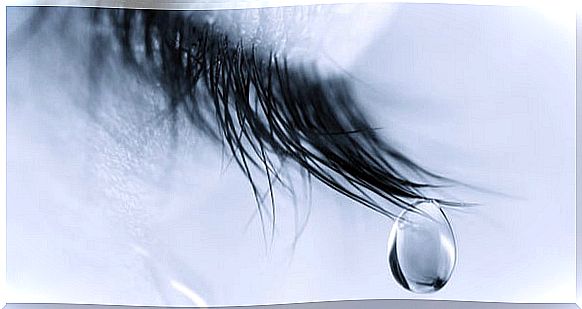Emotional Crying: Medicine To “drain ” The Soul

There are those who cry in silence, for a brief moment and in discreet solitude. However, the only way to restart, to drain sadness, frustrations and tensions is through emotional crying. Authentic relief is only possible through those tears that are shed like oceans tempered by a broken voice.
Psychobiology experts tell us that few behaviors make us as human as laughing and crying. In fact, both emotional expressions have many aspects in common. They have, for example, a component of “perseverance”. That is, when laughter or tears begin, they have a certain duration that cannot be easily shortened. In addition, both achieve the same goal: to make us feel better.
On the other hand, we all know that emotional crying – the one that produces the true relief – is not well seen socially. On the other hand, the discreet tear that slips in a political speech or in that trembling gaze moved by pride or by the contemplation of beauty is more accepted.
Perhaps for this reason, most of us avoid what is known as “vocal crying. ” It is always more comfortable to look for a dark corner where no one will see us to let the tears go, but yes, in very discreet silence. Lest someone hears us, sees us and discovers that we are not as strong as we appear.
However, psychiatrists and neurobiologists tell us very clearly: relief, whether alone or with someone, must be authentic, cathartic and liberating. Everything that implies a certain “self-control” continues to generate a component of tension and stress. Crying is necessary for the human being.

Emotional crying, a multipurpose behavior
Most babies when they come into the world, they cry. Now their cries are devoid of tears. The brain mechanism that will cause your lacrimal glands to secrete tears is not yet mature. However, their cries already fulfill an essential biological function: guaranteeing their survival by connecting with their peers to receive attention, care, comfort and affection.
Likewise, as we grow and mature, crying fulfills different interesting and useful functions. Although in reality, we do not always take advantage of them.
First, one of the purposes of crying is to remove toxins from the body caused by stress and anxiety. It is not necessary that anything negative has happened to us, that we feel sadness or grief. Sometimes we also cry from simple exhaustion, and the act of doing so is tremendously healthy.
From the School of Psychiatry of the University of Los Angeles (UCLA) they explain to us in a study that crying also serves a warning function. It’s like a wake-up call to your own conscience. There are times when we feel frustrated, overwhelmed by something we should react to and we don’t.
However, the simple act of letting go of tears sets in motion sophisticated biological mechanisms to allow us to see things more clearly.
Scientists tell us that emotional crying is actually an exceptional evolutionary innovation. It’s not just about “letting the tears fall.” The deep, authentic cry that allows us to fully vent activates the function of neurotrophins. It is a type of protein capable of promoting neuronal plasticity.
To put it another way, it “repairs us.” It encourages new learning and helps us to be more creative to implement new behaviors that will allow us to adapt much better to our environments.
Knowing how to confer support is an art that not everyone masters
The reality is as hard as it is obvious: not everyone knows how to give support. With words ” And now why are you crying?” or “Come on , that’s not important” , what we get is to block the person even more. Intensify negative emotion and dejection.
- When we need to facilitate emotional relief with someone, a good idea is to find the right person. Not everyone is worth it and not everyone has the appropriate strategies to facilitate that closeness, that ease in letting go of what hurts, what grips. Good friends, and of course, psychologists, can be the best guides in this process.
- Releasing ourselves to emotional crying in front of someone is not a reflection of weakness or vulnerability. It is the step that someone strong takes to vent tensions, fears and sadness. He does this for the purpose of rebuilding himself again, so that he can repair and receive help.
- Conferring support is not giving a hug. It is not saying “everything is fine. ” It is to be intuitive in order to facilitate relief, knowing how to promote it. It is knowing how to say “I am here, with you” without this being an imposition, and of course without judging. It is to be discreet while we are present, bringing closeness.
To conclude, despite how complicated it is to allow ourselves these moments of authentic emotional relief, either alone or in company, it is necessary to grant them from time to time. Draining the soul is a biological and psychological necessity. We cannot forget the classic phrase of “expressed emotion, overcome emotion”.









